|
DECATUR
was having its fun back in the "Gay Nineties",
but it also was having one of the most
interesting periods of its development as a
city. Replacing of old frame or brick
buildings, relics of other days, with modern
three to seven story business structures
featured that development. They are
buildings which are in use today. Decatur
had awakened to the fact that it had become a
city, and it went about the task of making
itself look like one, particularly in its
business district.
This period saw the beginning and expansion
of many of the big interests here today,
including the Mueller and Faries factories.
It was the continuation of public improvements,
such as paving, sewers and waterworks. In
1891 the sum of $66,288 was spent on sewers.
The following year the system was expanded to
the extent of $39,065. Those were great
sums in those days.
The first part of the decade was a
flourishing one. In the year 1891 the
total cost of buildings erected in Decatur was
$1,166,088. The next year the amount
passed $2,000,000. Then came the hard
times of 1893 and 1894 and the effect was felt
in the building line. In 1893, only
$900,000 was spent on buildings; in 1894, only
$600,000.
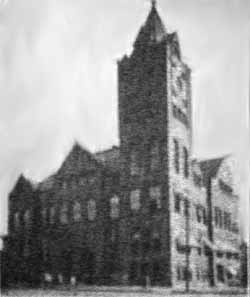
COURT HOUSE, 1892
But Decatur didn't stand still long. By
1895 the city had recovered its former stride,
and was going strong. That year the sum of
$1,300,000 was invested in building.
By the end of the Decatur had among its new
buildings The Review four story brick at North
and North Main streets, an addition to the high
school, a new transfer house, Syndicate block,1
the Millikin building, Morehouse &
Wells building, Pasfield building,
addition to Loeb building on North Water,
Young Brothers and Maris building on
East Cerro Gordo, Mattes
brick company plant, Decatur Cereal company
mill, Mueller plant on Cerro Gordo,
Shellabarger mill additions, Pugh, H. B.
Durfee, Oakland and Warren schools, the
beginning of the Wabash and Illinois Central
stations, Fairies factory, Library block (first
and second), Bohon block, Guards Armory,
Temple block, Wingate
block, Mueller Plumbing and Heating
company building, new St. Nicholas hotel, Parke
and Sons warehouse and court house. New
churches included the Congregational, St.
Johannes' Lutheran, Cumberland Presbyterian,
Christian tabernacle, East Park Baptist, First
Presbyterian and St. John's Episcopal.
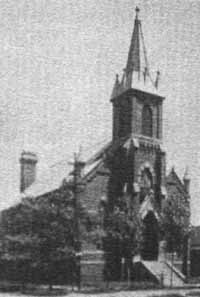
ST. JOHANNES' LUTHERAN CHURCH,
1892
In 1895 occurred the fire which destroyed the
Powers block on South Water street, and the
rebuilding of that block and the Powers Opera
House.
STORES AND INDUSTRIES
Some of the big stores in Decatur today had
their start during this period, among them the
Gushard, Stewart
and H. S. Gebhart dry goods companies.
Other stores started then and still in business
are the Bell drug store, the Folrath shoe
store and the Decatur drug company store.
Wholesale firms beginning business were D. F.
Riddell company, Stadler and
McClelland company, and Mueller,
Platt
and Wheeland company.
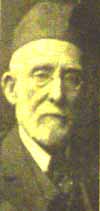
ROBERT FARIES
The Faries Manufacturing company was
organized in 1894. Robert Faries
had started years before as a workman, then
opened a small shop on Herkimer street, as East
Grand avenue was then called. Additions
were made from time to time. When the
Faries Manufacturing Company was organized,
he became the president, W. E. Surface
vice-president and superintendent, and E. P.
Irving secretary-treasurer. Many of
the articles manufactured by this company were
inventions of Mr. Faries.
Fixtures of various kinds, lamp holders,
boiler tube cleaners, gun cleaning rods, check
rower wire, and various other articles were made
by the firm.
The Decatur Cereal mill, which in later years
became the nucleus of the Staley
Manufacturing company's plant, was erected in
1895. It had a capacity of grinding ten
car loads of corn a day. The mill was
built by the Pratts. F. M. Pratt
and R. E. Pratt had been in the grain
business in Decatur since 1880. In 1891
they organized the Decatur Union Elevator
company, the name being changed later to the
Decatur Cereal Mill company. The Pratts
had branch offices in a number of cities in the
middle west.
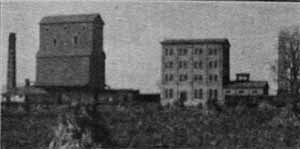
PRATT CEREAL MILL
(Later site of Staley plant)
W. H. Suffern moved his grain business
from Pierson to Decatur in 1891, and was joined
in 1892 by Robert I. Hunt. The
company incorporated as Suffern, Hunt
& Co., erected a mill later at Union street and
the Wabash. The same
men in 1907 built a cereal mill at Eldorado and
Van Dyke. It burned in 1909.
The U. S. Wire Mat company was incorporated
in 1892. Frank P. Wells was general
manager and treasurer, and C. M. Hurst
secretary. It developed a business which
as extended all over the world. It now is
the U. S. Manufacturing corporation, with J. L.
Bennett as president.
The Decatur Trunk factory was started in
1890.
The Home Manufacturing company, garment
makers, was organized about 1896 by C. M.
Allison and Fred H.
Benham. The latter did not remain
in the business long. It is now run by
Allison's son-in-law, John H. McEvoy.
The Macon County Farmers' institute was
started in 1895.
The present transfer house was built in 1895,
costing $2,700. It was paid for by
Subscriptions from merchants and property owners
adjacent to the square. The Street Railway
company donated $500 and agreed to furnish and
maintain the building.
More and more Decatur was taking on the
conveniences and dignity of a city. New
buildings required elevators. Pianos were
replacing reed organs in the homes. Brick
sidewalks were being laid. The period was
marked by the popularity of scroll work in
decorating houses. Many a house with this
fancywork pattern of architecture still stands.
Decatur had its first automobile in the 'ops
and it attracted about as much attention as
anything that had struck the city up to that
time. It was the Benz motor wagon
belonging to Hieronymus Mueller. It
came from Germany, arriving April 25, 1895.
Everybody in town was out to see the new
rubber-tired road wagon that ran without horses.
Horses, by the way, ran from it -- they were
frightened at the new-fangled vehicle, which
went down the street in a burst of noise and
glory - and also dust.
Life was gay in the '90s. There was no
suffering from lack of entertainment.

DECATUR GROUP AT MACKINAW, SEPT.
9, 1891
Left to right - Mrs.
Worsham, Mrs. B. F.
Sibley, Mrs. I. W.
Ehrman, John R.
Miller, Mrs. J. J.
Peddecord, Mrs. J. G. Cloyd, Mrs.
J. L. Peake,
Mrs. John R. Miller,
Mrs. M. A. Cloyd, J. G. Cloyd.
Outdoor recreation spots were popular.
Oakland and Riverside parks were at the heydey
of their careers. Fairview was being
developed as a city park. Excursions to
other places attracted many. A favorite
spot for many of Decatur's leading citizens was
Mackinaw, near Peoria. A delightful
camping ground along the P. D. & E. railroad,
with plenty of fish in the Mackinaw river
waiting for the hook, was too much temptation to
be missed. A picture shows a Decatur group
at Mackinaw on a camping excursion arranged by
John R. Miller. In the background
can be seen the railroad trestle. Mr.
Miller had a cottage there, as did eight or
ten others.
At home electric street cars were still so
novel that everyone must go trolley riding.
Trolley parties were the rage. Gay young
folks chartered a car for an evening, and had a
big thrill in going over the street car lines.
Bicycles had the same place in the hearts of
the travel-loving public as the automobiles of a
generation later. The first bicycles with
a high front wheel and small wheel behind, were
called "ordinaries". The "Star", with big
wheel in back, was another popular make.
The Star cyclists formed a club, which was the
predecessor of the Decatur Wheelmen's club,
which came into being after the "safety" wheel,
with its pneumatic tires, had come into general
use. It is the form of the bicycle today.

IN THE DAYS OF BICYCLES
Photo taken in 1890 at race track, where race
meet was held by Star Cycling club. Percy
Ewing, ower of the photo, at extreme right.
Others in the picture, so far as can be
identified, are L. W.
Hatch, Bell Telephone
company manager; W. Ermentrout,
Silas Long
and Mrs. Long;
Robert Spaulding, Leo Heilbrun,
Miss McDermott, --- Freeman,
Edwin Ewing and Mrs. Ewing, Harry
Shlaudeman, Troy Alexander, G.
R. Bohon,
Arthur
Alexander,
Frank Dodd, Fred Meech
of Assumption, Charles Saxton, Mrs.
Mathews, Ben
Shockley,
Charles Young and Mrs.
Young, Fred ("Bits") Mueller, Dr.
O. F. Corman.
Bicycle fans promoted bicycle races and
century rides, a century ride being 100 miles
made in twenty-four hours. A few made a
"double" century, 200 miles in twenty-four
hours. This was usually a trip from or to
Chicago. For a number of years the
Wheelmen's club flourished, and had a big
influence in promoting clean streets in Decatur.
There were in town two "bicycles built for
two", which were in demand by the young swains
who wanted to take their best girls for a ride.
The bicycle, by the way, cut into the livery
stable business in those days. Instead of
renting a horse and buggy the young man rented
bicycles. Paul Hiekisch, Orville
Ewing and others had bicycles for rent.
Women bicyclers, wearing bloomer outfits, at
first shocked the dignity of their elders, as
their daughters in a later day caused
consternation by their scantiness of dress.
The Fourth of July was always an occasion to
be duly celebrated. There was no lack of
patriotism, if one may judge by the hilarity and
gorgeousness of the celebrations. Parades,
speeches, shows, fireworks, all had their place
in the program. Members of various
organizations donned their very gladdest of
raiment and appeared in all their glory in the
processions.
In the cool of the summer evenings, Mr.
Business Man and his family were out in their
rubber-tired surrey enjoying a drive about town,
and perhaps stopping for a chat with friends
along the way. Social life was marked by
hospitality and informality. Walking was a
favorite pastime with many, and a hike to
Fairview or Riverside park was a delight.
Boating on the Sangamon, usually starting from
the landing at Riverside park, was a sport not
yet forgotten. From about 1895 to 1905,
the annual corn festivals were the big events of
the year. Corn was king in reality, even
to the extent of constructing a king out of
grains of corn. Arthur McBride
so combined the red, white and yellow grains as
to make a figure royal enough for any people.
This figure, with frame and throne of corn
stalks, held the place of honor at the festival.
Side shows set up in Central park and the
streets around it, lacked nothing in
attractions. The ferris wheel, the
merry-go-round, the animals, the trapeze
performances, the snake show, all and sundry,
amused the crowds while the pink lemonade,
popcorn and sandwich vendors refreshed them.
Even the moving picture, then in its infancy,
was to be seen, and as the picture moved its
flickering way across the screen, people
marveled at the sight.
An interesting social event, which brought to
mind the early days of the county, was the
golden wedding anniversary of Mr. and Mrs. J. Y.
Braden, which took place Jan. 23, 1890, at
their home north of Decatur.2
Mr. Branden and Miss Laura A.
Hunting were married Jan. 23, 1840, in the
old Central house on the west side of the 200
block North Main street, Justice Isaac C.
Pugh officiating. One of the wedding
guests was Richard J. Oglesby.
Naturally Mr. Oglesby received an
invitation to the golden wedding anniversary in
1890. Being unable to attend, he sent a
letter of congratulation, in which he said that
it was the first time he had ever received an
invitation to the fiftieth wedding anniversary
of a couple whose marriage he had attended fifty
years before.
Much more could be said of the good old days
of the '90s, but a big share of Decatur's
population can remember them for themselves.
There were periods of depression, also, such as
the railroad strike of 1894.
A LYNCHING
One of the exciting events of the period was
the lynching of a negro, known as Samuel J.
Bush, in 1893.
On May 29, a woman living south of Decatur,
had been assaulted by a negro, and on the
following day another woman, living between
Decatur and Mt. Zion, had suffered the same
experience. Posses were soon hunting for
the negro. Bush, who answered the
description, was captured in Moultrie county
June 2, and brought to the Macon county jail.
At 2:45 o'clock Saturday morning an armed mob
appeared at the jail. Chief of Police
Mason was thrown out of the way, the office door
and jail door were demolished with sledge
hammers and iron bars, the guards were
overpowered. Bush, stark naked, and
dragged out, protesting his innocence.
Halters from their horses were fashioned into a
noose by the mob leaders, and it was fastened to
an electric light pole at the northeast corner
of Water and Wood streets. A cab driver
was forced to drive his cab close to the pole so
the doomed man could climb up, and when the cab
was driven out from under him, his body was left
dangling in the air. The mob gave three
cheers for Mt. Zion and Decatur and hurriedly
dispersed.
Governor Altgeld offered a reward of
$200 for each of the lynchers, but authorities
were unsuccessful in learning the identity of
any of them.
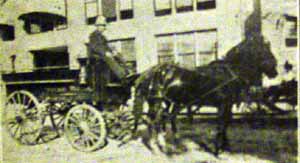
Decatur had its first patrol wagon in the
'90s , and from that time on many a Decatur boy
and girl was scared into submissive obedience by
threats of sending for the "kelly wagon".
First drivers of the wagon were Henry
Kossieck and Clayton Clements, the
former being on day duty. The two horses
that pulled the wagon were dubbed "Clayt" and
"Henry" in honor of their driers. The
accompanying picture of the first patrol wagon,
with Mr. Kossieck in the driver's seat,
was taken about 1896. It was called
"Kelly" wagon because a man named Kelly was the
first hauled in it.
--------------
1.
Syndicate block was built in 1890 by a syndicate
composed of Drs. W. J. and Cassidy Chenoweth,
Roberts and Greene, F. H. Converse, W. O.
McNabb, Julius Randall, John Mattes, and Elmer
Troutman.
2.
An interesting feature of the celebration was
the reading of an invitation to a party held on
Christmas in the year 1839 at the Decatur house,
at which Mr.
Graden
was one of the hosts. This invitation had
been issued to Jane
Williams, later Mrs.
Watt Culver, and she had preserved it all those
years. Other hosts, or "managers" as they
were called, at the party were H. M.
Gorin, Joseph
King, J. H. Elliott, William Bosworth, N.
Kibbee, Joseph
Williams,
John Ricketts, J. P.
Hickcok, E. O.
Smith, W. W.
Oglesby, S.
Prather and J. S.
Adamson.
Illinois Central trains were
stopped near the Braden home to accommodate the
210 guests who attended the golden wedding
celebration.
<PREVIOUS> <NEXT>
<CLICK HERE TO RETURN TO TABLE OF CONTENTS>
|